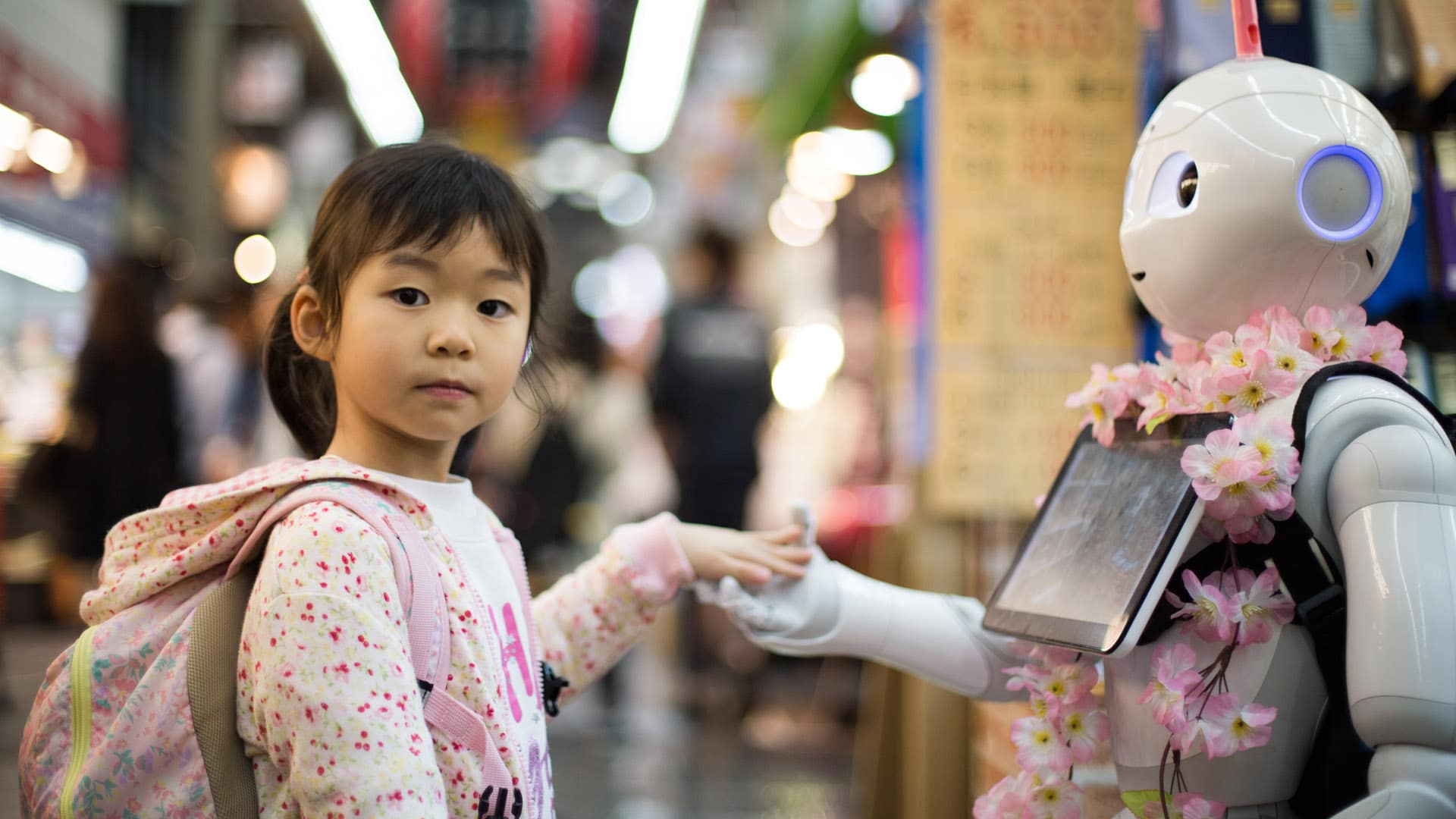When Alexa replied to my question about the weather by tacking on “Have a nice day,” I immediately shot back “You too,” and then stared into space, slightly embarrassed. I also found myself spontaneously shouting words of encouragement to ‘Robbie’ my Roomba vacuum as I saw him passing down the hallway. And recently in Berkeley, California, a group of us on the sidewalk gathered around a cute four-wheeled KiwiBot — an autonomous food-delivery robot waiting for the traffic light to change. Some of us instinctively started talking to it in the sing-song voice you might use with a dog or a baby: “Who’s a good boy?”
We’re witnessing a major shift in traditional social life, but it’s not because we’re always online, or because our technology is becoming conscious, or because we’re getting AI lovers like Samantha in Spike Jonze’s film “Her.” To the contrary, we’re learning that humans can bond, form attachments, and dedicate themselves to non-conscious objects or lifeless things with shocking ease. Our social emotions are now being hijacked by non-agents or jabbering objects such as Amazon’s Alexa, Apple’s Siri, or IBM’s Watson, and we’re finding it effortless, comfortable, and satisfying.
The sophistication level of human-like simulation that AI needs in order to elicit our empathy and emotional entanglement is ridiculously low. A Japanese study in 2008 showed that elderly residents of a senior care home were quickly drawn into substantial social interactions with a rudimentary, toy-like robot seal named “Paro.” The seniors experienced increased motor and emotional stimulation with the bot, but also increased social interactions with each other regarding Paro. Tests showed that the reactions of the seniors’ vital organs to stress improved after the introduction of the robot. And in a test in 2018 at the Max Planck Institute for Intelligent Systems in Germany, researchers built robots that administered “soft-warm hugs” to people, who reported feeling trust and affection for the robot — even saying that they felt “understood by” the robot. The point is not that robots are now such convincing counterfeit persons that we’re falling into relationships with them. It’s that humans are suckers for any vague sign of social connection. All of us are a hair’s breadth away from Tom Hanks’s character in “Cast Away,” who forges a deep bond with a volleyball he names Wilson.
Recently, science has come to understand the emotions of social bonding, and I think it helps us understand why it’s so easy to fall into these “as-if intimacies” with things. Care or bonding is a function of oxytocin and endorphin surging in the brain when you spend time with another person, and it’s best when it’s mutual and they’re feeling it too. Nonhuman animals bond with us because they have the same brain chemistry process. But the system also works fine when the other person doesn’t feel it — and it even works fine when the other person isn’t even a “person.” You can bond with things that cannot bond back. Our emotions are not very discriminating and we imprint easily on anything that reduces the feeling of loneliness. But I think there’s a second important ingredient to understanding our relationship with technology.
The proliferation of devices is certainly amplifying our tendency for anthropomorphism, and many influential thinkers claim that this is a new and dangerous phenomenon, that we’re entering into a dehumanizing “artificial intimacy” with gadgets, algorithms, and interfaces. I respectfully disagree. What’s happening now is not new, and it’s more interesting than garden-variety alienation. We are returning to the oldest form of human cognition — the most ancient pre-scientific way of seeing the world: animism.
Animistic beliefs dominate the everyday lives of people in Southeast and East Asia, as I discovered while living there for several years. Local spirits, called neak ta in Cambodia, inhabit almost every farm, home, river, road, and large tree. Thai people usually refer to these spirits as phii, and the Burmese call them nats. The next time you visit a Thai restaurant, notice the spirit house near the cash register or kitchen, probably decorated with offerings such as flowers, fruit, even a shot of alcohol. These offerings are designed to please neak ta and phii, but also to distract and pull mischievous spirits into the mini-homes, thereby saving the real homes from malady and misfortune. Animism was never entirely supplanted by modern beliefs, and we see it fancifully portrayed in the Japanese films of Hayao Miyazaki.
Like my relationship with Alexa, animists have the same as-if perspective toward their spirits. They understand that the shot glass of booze is not really consumed by the thankful ghost (it’s still there the next day), but they gently commit to it anyway.
Animism is strong in Asia and Africa, but really it is everywhere around the globe, just below the surface of more conventional official religions. In actual numbers and geographic spread, belief in nature spirits trounces monotheism, because even the one-godders are closet animists. Spend some time in New Orleans, with its voodoo and hoodoo cultures, and you’ll see that animism is alive and interwoven with mainstream religions such as Catholicism.
The word “animism” was first employed by the English anthropologist Edward Burnett Tylor to describe the early “primitive” stage of human religion — a stage that was eventually supplanted by what was later called Axial Age monotheism, which in turn would be supplanted, Tylor hoped, by what we’d call Deism. Anthropologists today debate the usefulness of the term animism since folk religions are so diverse, but two essential features mark all animism: one, belief that there are “agents” or even persons in natural objects and artifacts (and even geographic places); and two, belief that nature has purposes (teleology) woven throughout it. Animism commits to the view that there are many kinds of persons in the world, only some of whom are humans.
Sigmund Freud typified the usual condescension about animism when he wrote in “Totem and Taboo” that “spirits and demons were nothing but the projection of primitive man’s emotional impulses.” But I want to extend the more charitable view of David Hume that we are all somewhat animistic — even secular humanists and science devotees. “There is a universal tendency among mankind to conceive all beings like themselves and to transfer to every object those qualities with which they are familiarly acquainted and of which they are intimately conscious.”
Animism is not so much a set of beliefs as a form of cognition. I think we are all natural-born animists, and those of us in Western developed countries slowly learn to discount this mode of cognition in favor of a mechanical view of the world. Indigenous approaches to nature are dubbed uneducated or juvenile because they use agency and purpose to think about nature (e.g. “the pine tree is for the warbler,” or “the river wants revenge,” etc.). However, some philosophers and psychologists are striking back, pointing out that animistic thinking reveals many of the subtle ecological relations in nature that mechanical approaches miss.
If animist thinking is childish and uneducated, then why are indigenous peoples so much better at surviving and thriving in local natural ecologies? Some kinds of animism are adaptive and aid our survival, because they focus our attention on ecological connections, but they also train our social intelligence to predict and respond to other agents. If your world is thick with other agents — all vying for their desires and goals — then you spend a lot of time organizing, revising, and strategizing your own goals in a social space of many competing aims.
So our new “technology-animism” might not be detrimental at all. I might not really be “helping” the robot, and it might not be “helping” me, but behaving as if we’re actually relating — even bonding — keeps our empathic skills honed and ready for when it really counts. Immersion in technology relationships is not creating the loneliness epidemic. It’s a response to it. The actual causes of the loneliness epidemic started way before digital dominance. Our new animism — animism 2.0 — might be quite helpful in keeping the social emotions and skills healthy enough for real human bonding, perspective-taking, and empathy. Instead of dehumanizing us, this technology-animism could actually be keeping us human.
Stephen T. Asma is professor of philosophy at Columbia College Chicago and a member of the Public Theologies of Technology and Presence program at the Institute of Buddhist Studies in Berkeley, California.
![]()
This article was originally published at Aeon and has been republished under Creative Commons.











